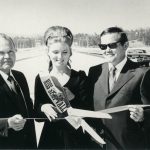Transit in Transition: A UCLA event on the future of public transportation

Across the country, transit is in a state of transition. The pandemic has shifted more workers into remote work and upended “traditional” commuting trends. Labor shortages, rather than funding, are emerging as key barriers to providing service. New mobility technologies that launched with the promise of filling first/last-mile mobility gaps withered during the last couple of years.
More than 150 people gathered for the UCLA Lake Arrowhead Symposium, held April 1 at UCLA Covel Commons, to discuss these and other pressing issues impacting transit. The event was an in-person continuation of a fall 2021 webinar series.
One of the event’s main highlights was a conversation about the future of transportation in Los Angeles with some of the region’s most influential leaders — Kome Ajise, executive director of the Southern California Association of Governments (SCAG), Seleta Reynolds, general manager of LADOT, and Stephanie Wiggins, CEO of LA Metro.
The speakers covered a range of issues pertinent to public transportation in Greater Los Angeles, including (but not limited to) balancing transit’s role as a social service with the need to accumulate sufficient fare revenue to operate without constraints, and what’s truly necessary to initiate a shift toward more transit ridership.
The discussion was moderated by UCLA ITS director and professor Brian D. Taylor, who posed a broad question: What’s the vision for the future of transit in the region?
Ajise answered unequivocally. Transit is the “backbone of our system,” he said, and the future cannot be carried on the freeways. To mitigate freeway demand, Ajise gestured toward one of the panel’s main themes: the importance of road pricing.
“Over time, as capacity continues to be constrained, it probably should cost more to drive,” he said.
Congestion pricing involves setting prices for accessing roadway infrastructure such as busy thoroughfares and freeways. Across the length of the hour-long panel, each participant agreed that the fate of transit is, to some extent, tied to the idea that drivers pay a higher price. If driving is underpriced and overprioritized, drivers will stay off transit and remain behind the wheel.
And, as Wiggins mentioned, priced lanes make traffic flow freely, improving commute times for drivers and bus riders. Improving transit frequency and expanding the reach of transit is pivotal, but insufficient in dealing with present-day congestion issues and climate concerns.
“If we’re concerned about climate and mode shift, pricing is our future,” Wiggins said.
The panelists also discussed adapting their service for a post-pandemic world. Reynolds highlighted the need for agencies to think of themselves as all-day and all-types of service providers, not just of service to white-collar workers going to and from the office.
The traditional commute-hour focus for transit providers is becoming increasingly obsolete as work-from-home trends accelerate and the center-city dominance fades, Reynolds said.
“I hope we don’t go back to focusing on job centers,” she said.
The speakers occasionally disagreed on some issues, most notably on the best ways to address concerns surrounding shading and bus shelters. Ajise said that the need for shelter is directly tied to headways: If riders don’t have to wait very long for the bus, shelters are much less necessary. Wiggins disagreed, pointing out that rail stops mostly have shelters and arguing that the acceptance of the status quo reflects the belief that buses are an inferior product, instead of the backbone of the transit system.
Ultimately, all speakers agreed that the future of LA’s transportation must curb car use and re-imagine transit as a comprehensive transportation option, not limited to simply doing what it’s always done.
Other panels during the day-long event also successfully navigated pressing issues in the world of transit.
In the morning session, Lewis Center director Evelyn Blumenberg moderated a panel on broader trends affecting demand for transit. Arizona State University professor Deborah Salon presented results from a thorough survey she and her team conducted on COVID-era work-from-home preferences, finding that a large chunk of commuters prefer to stay home for the foreseeable future. Jerry Nickelsburg, faculty director of the UCLA Anderson Forecast, used macroeconomic data to argue that demand for office space is, perhaps surprisingly, in a strong place. And UCLA Luskin professor Michael Manville highlighted the need to shift away from transit ridership as a metric for transit system success.
In the afternoon, UCLA ITS project manager Jacob Wasserman moderated the “Key Issues in Transit Finance and Labor” panel, where Conan Cheung, Metro COO of bus operations, and Investing In Place executive director Jessica Meaney debated the recent decisions made by Metro to reduce service by 20% to 30%.
Cheung argued that the reduction in service was necessary to match the quantity of available bus operators: Reductions, he said, would allow for more arrival time predictability, a key metric for bus riders. Meaney, on the other hand, suggested that Metro’s starting wages for drivers were too low to attract a dedicated workforce, and that the stagnation in vehicle revenue hours over the last quarter-century was deeply unfair to the people who rely on Metro to get around. Joshua Schank, managing principal at InfraStrategies and UCLA ITS senior fellow, largely agreed with Meaney’s assessment, adding that Metro’s confusing governance structure inevitably leads to these kinds of decisions.
Finally, to close the day, Manville returned to moderate the panel on “COVID Disrupting Disruptive Mobility.” The three panelists — University of Oregon professor Anne Brown, Circuit Director Of Transit Development Alyssa Haerle, and The Rideshare Guy founder Harry Campbell — discussed the feasibility of ride-hailing to provide first/last-mile connectivity, the pros and cons of driver flexibility, and alternative models of ride-hailing, such as Circuit, which provides electric-powered shuttles for short trips in cities across the United States. Haerle explained that Circuit, in contrast to Uber’s independent contractor model, hires their drivers as full-time employees.
For more information about the event, visit www.uclaarrowheadsymposium.org.
Recent Posts

MURP student ‘speaking up’ for equity in transportation and planning
Veronica De Santos spent a semester abroad in Geneva, where she called on global leaders to invest in underrepresented voices shaping the future of sustainability and transportation.

Remembering Donald Shoup
UCLA ITS’ 2nd director and a visionary scholar reshaped cities with his pioneering work on parking, inspiring legions of ‘Shoupistas’ and lasting change.










